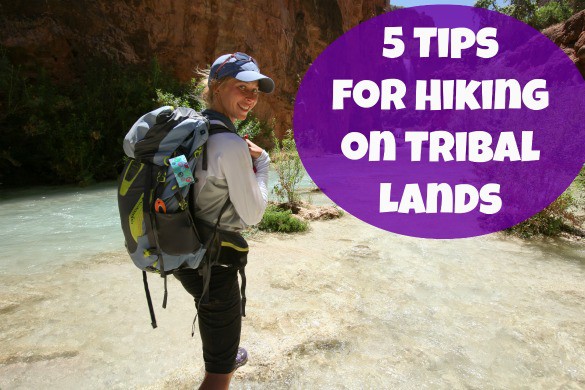Don’t Be ‘That’ Girl: 5 Tips for Hiking on Tribal Lands
Remember our Take a Hike With Kate series? She’s back today with everything you need to know about hiking on tribal lands, as she’s been doing as she trains for her BIG Havasupai adventure!
If you’re hiking in the Southwest to prepare for a hike to Havasupai Falls or the Grand Canyon, you may end up exploring and hiking on Tribal lands. This may include Navajo, Zuni, Ute, Hualapai and Hopi lands, as well as Havasupai, of course.
These tribal lands are home to some spectacular scenery, weather and people. But it’s far too common that hikers assume that things on tribal lands are the same as other areas. There are some important differences and things you’ll want to know to stay safe and remain respectful of our country’s native cultures.
1. Practice leave no trace. First of all, as always practice leave no trace practices. If you’re unsure if that includes tossing your orange peels, read this. Some buildings and structures on tribal lands may be very old! Don’t climb them or disturb them. This includes artifacts including pot shards — in fact, Tribal and federal laws prohibit removal of items. Also, most tribes do not permit alcoholic beverages on the reservation, and firearms are also prohibited.
2. Use caution when coming in. The Arizona Office of Tourism says, “Use caution when driving, especially at night. Much of the reservation land is open range, and small herds of sheep, goats, cattle and horses move freely along and across roads.” Depending on where you are traveling, you may want to consider bringing additional gas or making sure to locate a gas station ahead of time.
3. Read up on the tribes you’ll be visiting. Familiarizing yourself with the history of a tribe will often bring insight into their landscape and cultural practices. Not all Native cultures and traditions are the same; books, museums and internet blogs are great resources. While traveling if you come across dances, ceremonies or festivals be respectful, ask questions and remember that you are a guest.
Arizona Outback Adventures, the company I’m traveling with also offers these suggestions, specifically for the Havasupai:
“The Havasupai are a secluded, kind and generous people who often come across to visitors as shy and quiet. We encourage you to interact with and learn about these people who have opened their sacred home to us. Out of respect for the Tribal members and their beliefs, please do not take photos of individuals or homes without first asking permission. Many of the Havasupai will allow their photo to be taken, however please be respectful of the fences and their privacy.” This is good advice for global exploring and traveling on Native lands.
4. Be prepared. You’ll also want to research hikes ahead of time and carry a topographical map at all times. Some tribal lands do not want cars parked at trailheads, so you may need to arrange for other transportation. Never hike if there’s a chance of rain as flash floods are common. A day hike first aid kit, compass and emergency kit are also must-have items as you’ll likely be out of range of a cell phone signal. (See my packing list here!)
5. Check into regulations before camping. For example, to visit the Navajo nation, the country’s largest reservation, you’ll need a valid camping, hiking or back-country permit issued by the Navajo Parks and Recreation Department or other tribal authority.
ADOT advises, “Guides are required to visit some reservation sites, such as Antelope Canyon near Lake Powell or the inner depths of Canyon de Chelly near Chinle.”
These are just basic guidelines. Be a good hiker and do your research, come prepared, and make sure you’re respectful of tribal lands and people — no matter where you’re hiking!
Have you ever hiked on tribal lands before? —Kate

